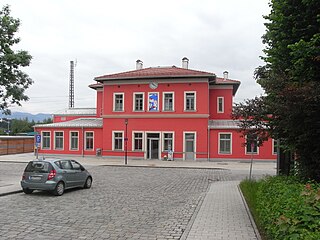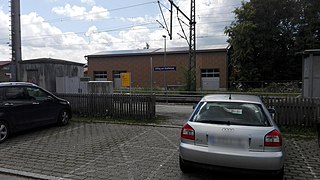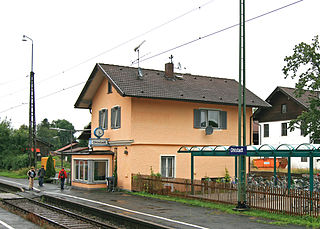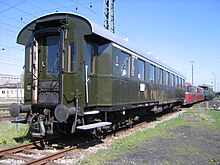
The Deutsche Bahn AG is the national railway company of Germany, and a state-owned enterprise under the control of the German government. Headquartered in the Bahntower in Berlin, it is a joint-stock company (AG).

DB Fernverkehr AG is a semi-independent division of Deutsche Bahn that operates long-distance passenger trains in Germany. It was founded in 1999 in the second stage of the privatisation of Deutsche Bahn, under the name of DB Reise&Touristik and was renamed in 2003.

Innsbruck Hauptbahnhof is the main railway station in Innsbruck, the capital city of the Austrian federal state of Tyrol. Opened in 1853, the station is a major hub for western and central Austria. In 2019, it was the 8th-busiest station in the country, and the 2nd-busiest outside of Vienna after only Linz Hauptbahnhof, with 315 train movements and 38,500 passengers daily.

A Schnellzug is an express train in German-speaking countries, where it refers to trains that do not stop at all stations along a line. The term is used both generically and also as a specific train type. In Germany and Austria it is also referred to colloquially as a D-Zug, a short form of Durchgangszug, and express train services were often given numbers preceded by the letter D. The similar term, snälltåg, was used in Sweden until January 1980.

The Munich–Garmisch-Partenkirchen railway is a single track, electrified main line railway in the southern part of the German state of Bavaria. It runs from Munich via Starnberg and Murnau to Garmisch-Partenkirchen. The first part of it was opened in 1854 and is one of the oldest lines in Germany.

The Ausserfern Railway is a cross-border railway line in the German state of Bavaria and the Austrian state of Tyrol. The single-tracked branch line starts from Kempten in Germany, before crossing into Austria just after passing through Pfronten. It then transits the Außerfern area around Reutte, before passing back into Germany in order to terminate at Garmisch-Partenkirchen.

Intercity (IC) is the second-highest train classification in Germany, after the Intercity Express (ICE). Intercity services are loco-hauled express train services, usually over long-distances. There are Intercity routes throughout Germany, and routes generally operate with a two-hour frequency, with multiple routes giving a more frequent service on core routes. Intercity services are operated by the DB Fernverkehr sector of Deutsche Bahn.

Garmisch-Partenkirchen station is a junction station in the German State of Bavaria. It is the biggest station in Garmisch-Partenkirchen. It has five platform tracks and is classified by Deutsche Bahn as a category 3 station. The station has about 50 services daily operated by DB Regio and some long-distance services operated by Deutsche Bahn. It is on the lines connecting Munich and Garmisch-Partenkirchen, Garmisch-Partenkirchen and Innsbruck and Garmisch-Partenkirchen and Reutte.

The Mittenwald Railway, popularly known as the Karwendelbahn, is a railway line in the Alps in Austria and Germany. It connects Innsbruck via Seefeld and Mittenwald to Garmisch-Partenkirchen.

Tutzing station is currently the only station of the Bavarian town of Tutzing and a station on the Munich S-Bahn. It is classified by Deutsche Bahn as a category 4 station and has three platform tracks. It is served daily by about 130 trains operated by Deutsche Bahn, including 50 S-Bahn trains. Tutzing station is located on the Munich–Garmisch-Partenkirchen railway and is the beginning of the Kochelsee Railway to Kochel.

Weilheim (Oberbay) station is the station of the Bavarian district town of Weilheim in Oberbayern. It is a crossing station on the Munich–Garmisch-Partenkirchen railway, the Ammersee Railway from Mering and the Weilheim–Peißenberg railway. It is classified by Deutsche Bahn as a category 4 station and has five platform tracks. It is served by about 100 trains daily operated by Deutsche Bahn and Bayerische Regiobahn (BRB).

Mittenwald station is a railway station in the German State of Bavaria, in the town of Mittenwald. It has three platform tracks and is classified by Deutsche Bahn (DB) as a category 4 station.

Murnau station is a railway station in the municipality of Murnau am Staffelsee, located in the Garmisch-Partenkirchen district in Bavaria, Germany. It is located on the Munich–Garmisch-Partenkirchen railway of Deutsche Bahn.

Eschenlohe station is a railway station in the municipality of Eschenlohe, in the Garmisch-Partenkirchen district in Bavaria, Germany. It is located on the Munich–Garmisch-Partenkirchen railway of Deutsche Bahn.

Innsbruck Hötting railway station is a railway station in the borough of Hötting in Innsbruck, the capital city of the Austrian state of Tyrol. It is the first station on the Mittenwald Railway (Karwendelbahn) north of Innsbruck West station, where the line branches off the Arlberg railway. The station was opened in 1912 and is served by trains operated by both Deutsche Bahn and Austrian Federal Railways (ÖBB).

Huglfing station is a railway station in the municipality of Huglfing, in Bavaria, Germany. It is located on the Munich–Garmisch-Partenkirchen railway of Deutsche Bahn.

Uffing am Staffelsee station is a railway station in the municipality of Uffing am Staffelsee, in Bavaria, Germany. It is located on the Munich–Garmisch-Partenkirchen railway of Deutsche Bahn.

Ohlstadt station is a railway station in the municipality of Ohlstadt, in Bavaria, Germany. It is located on the Munich–Garmisch-Partenkirchen railway of Deutsche Bahn.

Oberau station is a railway station in the municipality of Oberau, in Bavaria, Germany. It is located on the Munich–Garmisch-Partenkirchen railway of Deutsche Bahn.

Farchant station is a railway station in the municipality of Farchant, in Bavaria, Germany. It is located on the Munich–Garmisch-Partenkirchen railway of Deutsche Bahn.




















